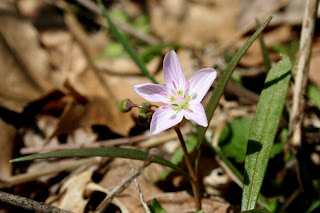Last Saturday, March 15, I went on a field trip with Virginia Master Naturalists. We were blessed with warm, somewhat sunny weather that was sandwiched in between a rainstorm the night before and another one that evening.
The trip was led by Betsy Stinson, wildlife biologist with Virginia's Department of Game and Inland Fisheries, and Jeff Kirwan, forester with Virginia Cooperative Extension/4-H programs. The focus of the trip was on forest ecology with the interaction between trees and mammals.

We first observed this beaver den where a Canadian Goose posed for scale.

While Betsy was telling us about beavers, a Red-Winged Blackbird ate insects on the den.
Hazel or Common Alders, small trees or shrubs, were all around the perimeter of the large pond. This is the only alder we have in this part of Virginia.

The male flowers on the 3" long catkins were just beginning to bloom. You can also see a female flower beginning to bloom on cones in left part of the background.

These cones from last year are cute, only about 3/4" long. Besides alders, we learned about the interaction between insects, squirrels, and acorns. Sadly, we also saw gypsy moth eggs on chestnut oak trees.

We hiked from the pond through the woods where we saw sign of deer. Besides feces (1-1/2"oval pellets), we saw this sign of a deer rubbing on a small tree. Betsy probably said he was establishing his territory.
Hiking onto the Poverty Creek Trail following a small creek, we found more sign of beaver. Several large trees were felled but nothing done with them. Why did the beaver go to all this trouble and not use the tree for anything as far as I could tell?

This beaver dam took a lot of work but it was worthwhile, creating a little pond.

At the edge of the beaver pond, the water was reddish, probably from the iron in the soil the naturalists theorized. One naturalist walked over to ask what I was photographing and I said "colors." He looked at me strangely, disappointed that I had not found any salamanders. I guess everyone looks at nature differently.

We heard the sounds of peepers and wood frogs. Betsy caught this small wood frog who posed for all the photographers in the group.
NOTE: Pandapas Pond is a man-made pond in the Jefferson National Forest, only 4 miles from Blacksburg. The day use area is popular with hikers, birdwatchers, runners, trout fishermen and naturalists.


















